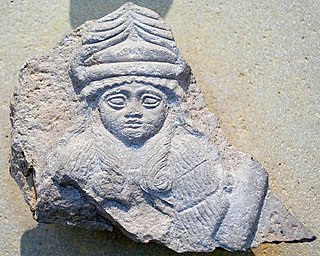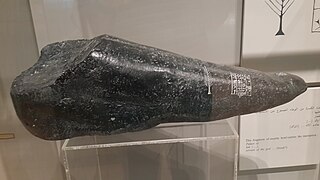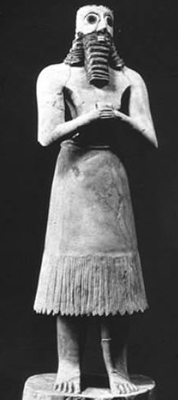
Ninḫursaĝ sometimes transcribed Ninursag, Ninḫarsag, or Ninḫursaĝa, also known as Damgalnuna or Ninmah, was the ancient Sumerian mother goddess of the mountains, and one of the seven great deities of Sumer. She is known earliest as a nurturing or fertility goddess. Temple hymn sources identify her as the "true and great lady of heaven" and kings of Lagash were "nourished by Ninhursag's milk". She is the tutelary deity to several Sumerian leaders.
Nintinugga was a Mesopotamian goddess associated with medicine and cleansing. She belonged to the local pantheon of Nippur. While she has been compared to other similar goddesses, such as Ninisina and Gula, and in a number of ancient texts they appear to be syncretised with each other or are treated as interchangeable, she was nonetheless a distinct deity in her own right. She was associated with Enlil and Ninlil, and was worshiped in their temples, though houses of worship dedicated only to her are also attested.

Bau, also read Baba (cuneiform: 𒀭𒁀𒌑 dBa-U2), was a Mesopotamian goddess. The reading of her name is a subject of debate among researchers, though Bau is considered the conventional spelling today. While initially regarded simply as a life-giving deity, in some cases associated with the creation in mankind, over the course of the third and second millennia BCE she also acquired the role of a healing goddess. She could be described as a divine midwife. In art she could be depicted in the company of waterfowl or scorpions.

Nanshe was a Mesopotamian goddess in various contexts associated with the sea, marshlands, the animals inhabiting these biomes, namely bird and fish, as well as divination, dream interpretation, justice, social welfare, and certain administrative tasks. She was regarded as a daughter of Enki and sister of Ningirsu, while her husband was Nindara, who is otherwise little known. Other deities who belonged to her circle included her daughter Nin-MAR.KI, as well as Hendursaga, Dumuzi-abzu and Shul-utula. In Ur she was incorporated into the circle of Ningal, while in incantations she appears alongside Ningirima or Nammu.

Ninshubur, also spelled Ninšubura, was a Mesopotamian goddess whose primary role was that of the sukkal of the goddess Inanna. While it is agreed that in this context Ninshubur was regarded as female, in other cases the deity was considered male, possibly due to syncretism with other divine messengers, such as Ilabrat. No certain information about her genealogy is present in any known sources, and she was typically regarded as unmarried. As a sukkal, she functioned both as a messenger deity and as an intercessor between other members of the pantheon and human petitioners.
Ninti was a Mesopotamian goddess worshiped in Lagash. She was regarded as the mother of Ninkasi. She also appears in the myth Enki and Ninhursag as one of the deities meant to soothe the eponymous god's pain. In this text, her name is reinterpreted first as "lady rib" and then as "lady of the month" through scribal word play.
Pabilsaĝ was a Mesopotamian god. Not much is known about his role in Mesopotamian religion, though it is known that he could be regarded as a bow-armed warrior deity, as a divine cadastral officer or a judge. He might have also been linked to healing, though this remains disputed. In his astral aspect, first attested in the Old Babylonian period, he was a divine representation of the constellation Sagittarius.
Ninazu was a Mesopotamian god of the underworld of Sumerian origin. He was also associated with snakes and vegetation, and with time acquired the character of a warrior god. He was frequently associated with Ereshkigal, either as a son, husband, or simply as a deity belonging to the same category of underworld gods.
Ningirida was a Mesopotamian goddess regarded as the wife of Ninazu and mother of Ningishzida. Little is known about her character beyond her relation to these two gods.
Ninimma was a Mesopotamian goddess best known as a courtier of Enlil. She is well attested as a deity associated with scribal arts, and is variously described as a divine scholar, scribe or librarian by modern Assyriologists. She could also serve as an assistant of the birth goddess Ninmah, and a hymn describes her partaking in cutting of umbilical cords and determination of fates. It has also been suggested that she was associated with vegetation. In the Middle Babylonian period she additionally came to be viewed as a healing deity.
Šulpae was a Mesopotamian god. Much about his role in Mesopotamian religion remains uncertain, though it is agreed he was an astral deity associated with the planet Jupiter and that he could be linked to specific diseases, especially bennu. He was regarded as the husband of Ninhursag. Among the deities considered to be their children were Ashgi, Panigingarra and Lisin. The oldest texts which mention him come from the Early Dynastic period, when he was worshiped in Kesh. He is also attested in documents from other cities, for example Nippur, Adab and Girsu. Multiple temples dedicated to him are mentioned in known sources, but their respective locations are unknown.

Ninkarrak was a goddess of medicine worshiped chiefly in northern Mesopotamia and Syria. It has been proposed that her name originates in either Akkadian or an unidentified substrate language possibly spoken in parts of modern Syria, rather than in Sumerian. It is presumed that inconsistent orthography reflects ancient scholarly attempts at making it more closely resemble Sumerian theonyms. The best attested temples dedicated to her existed in Sippar and in Terqa. Finds from excavations undertaken at the site of the latter were used as evidence in more precisely dating the history of the region. Further attestations are available from northern Mesopotamia, including the kingdom of Apum, Assyria, and the Diyala area, from various southern Mesopotamian cities such as Larsa, Nippur, and possibly Uruk, as well as from Ugarit and Emar. It is possible that references to "Ninkar" from the texts from Ebla and Nikarawa, attested in Luwian inscriptions from Carchemish, were about Ninkarrak.

Ninisina was a Mesopotamian goddess who served as the tutelary deity of the city of Isin. She was considered a healing deity. She was believed to be skilled in the medical arts, and could be described as a divine physician or midwife. As an extension of her medical role, she was also believed to be capable of expelling various demons. Her symbols included dogs, commonly associated with healing goddesses in Mesopotamia, as well as tools and garments associated with practitioners of medicine.

Inzak was the main god of the pantheon of Dilmun. The precise origin of his name remains a matter of scholarly debate. He might have been associated with date palms. His cult center was Agarum, and he is invoked as the god of this location in inscriptions of Dilmunite kings. His spouse was the goddess Meskilak. A further deity who might have fulfilled this role was dPA.NI.PA, known from texts from Failaka Island.

Gula was a Mesopotamian goddess of medicine, portrayed as a divine physician and midwife. Over the course of the second and first millennia BCE, she became one of the main deities of the Mesopotamian pantheon, and eventually started to be viewed as the second highest ranked goddess after Ishtar. She was associated with dogs, and could be depicted alongside these animals, for example on kudurru, and receive figurines representing them as votive offerings.
Dumuzi-abzu, sometimes spelled Dumuziabzu, was a Mesopotamian goddess worshiped in the state of Lagash. She was the tutelary deity of Kinunir.
Ukulla, also called Ugulla, Kulla or Kullab, was a Mesopotamian goddess regarded as the wife of Tishpak. She was chiefly worshiped in Eshnunna. Based on the variable spelling of her name in cuneiform it has been suggested that much like her husband and their son Nanshak she had neither Sumerian nor Akkadian origin.
Lammašaga was a Mesopotamian goddess who functioned as the sukkal of Bau. She belonged to a class of protective deities known as Lamma. She was originally worshiped in Lagash and Girsu, though attestations are also available from other cities. A hymn focused on her was copied in scribal schools in the Old Babylonian period.
Meskilak or Mesikila was one of the two main deities worshiped in Dilmun. The other well attested member of the pantheon of this area was Inzak, commonly assumed to be her spouse. The origin of her name is a subject of scholarly dispute. She is also attested in texts from Mesopotamia, where her name was reinterpreted as Ninsikila. A different deity also named Ninsikila was the spouse of Lisin, and might have started to be viewed as a goddess rather than a god due to the similarity of the names. Under her Mesopotamian name Meskilak appears in the myths Enki and Ninhursag and Enki and the World Order, in which she is associated with Dilmun.
Nin-MAR.KI was a Mesopotamian goddess. The reading and meaning of her name remain uncertain, though options such as Ninmar and Ninmarki can be found in literature. In the past the form Ninkimar was also in use. She was considered the divine protector of cattle, and additionally functioned as an oath deity. She might have been associated with long distance trade as well. It is possible that in art she was depicted in the company of birds, similar to her mother Nanshe. Other deities associated with her include other members of the pantheon Lagash, such as Dumuzi-abzu and Hendursaga.






